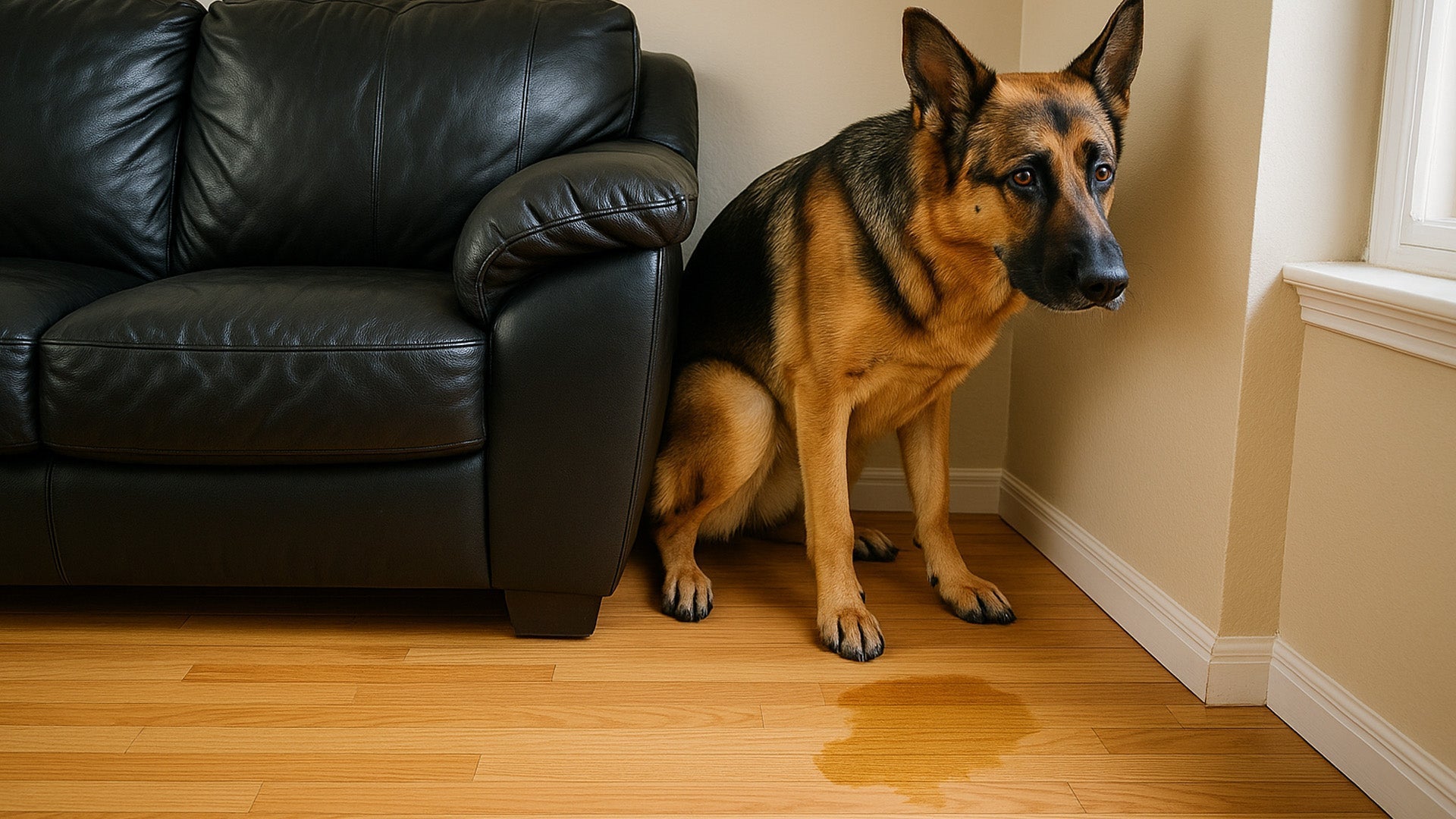Dogs often urinate inside because they are stressed, sick, or haven't been trained properly, leaving owners to wonder, Why is my dog peeing in the house? You need to deal with this behavior if you want to keep your home clean and grow closer to your pet. Learning how to discourage a dog from peeing in the house requires constant training, positive reward, and the discovery of root causes in order to effect long-lasting behavior changes.
Understanding Why Dogs Pee Indoors ?
Medical Reasons
Urinary Tract Infections
Pain or discomfort from UTIs may cause frequent accidents, consult your vet for diagnosis and treatment. (PetMD)
Diabetes or Kidney Issues
Increased urination from these conditions can lead to indoor accidents, veterinary care is essential.
Hormonal Imbalances
Conditions like spay incontinence can disrupt bladder control, and a vet can recommend appropriate treatments.
When to Consult a Vet
Seek professional advice if indoor urination persists despite training or if symptoms like excessive thirst or lethargy appear. This is important when considering how to stop your dog from peeing indoors
Behavioral Reasons
Marking Territory
Dogs may urinate indoors to claim spaces. Neutering and consistent boundaries can help if you're wondering how to stop adult dogs from peeing in the house.
Anxiety and Stress
Stress triggers like loud noises or separation can cause accidents. To discourage a dog from peeing in the house, create a calming environment for your dog to reduce anxiety and prevent indoor urination.
Incomplete House Training
Gaps in training can lead to confusion. Reinforce positive habits with patience and consistency.
Attention-Seeking Behavior
Dogs may urinate to gain attention; address this by reinforcing positive actions and ignoring unwanted behaviors.
Environmental Factors

Changes in Routine
Sudden routine changes may confuse your dog and maintain consistency to prevent accidents.
New Pets or Family Members
Introducing new household members can cause insecurity and gradually acclimate your dog to the changes.
Inconsistent Schedules
Stick to a reliable daily routine for your dog to learn how to stop a dog from peeing in the house and encourage consistent bathroom behavior. Regular feeding and potty times can help establish consistent habits.
Preventive Measures for House Training Early House Training Techniques
Starting house training early sets the foundation for good habits in puppies. Crate training helps teach bladder control by creating a designated space for your dog. Using a playpen can also provide a safe and confined area for your puppy, helping them learn where to go without accidents around the house. Using positive reinforcement techniques, such as rewarding your puppy immediately after successful outdoor elimination, encourages desired behavior and strengthens the bond between you and your pet. Consistency is key for success, especially when learning how to discourage a dog from peeing in the house.
Setting a Routine
Establishing regular feeding and potty schedules helps your dog learn when to expect bathroom breaks. Consistency is crucial in reinforcing good habits, ensuring your dog understands where and when to go. By setting a routine, you can significantly reduce accidents indoors, making it easier to figure out how to stop dogs from peeing in the house.
Creating a Designated Potty Area
Selecting an appropriate outdoor spot for your dog to eliminate ensures consistency and helps them associate that area with bathroom time. Using scent attractants can further encourage your dog to go in the right spot, making it easier to reinforce good habits. This approach plays a key role in preventing accidents and teaching your dog where to pee. (AKC)
Correcting the Behavior

Immediate Response to Accidents
Redirect your dog to the proper potty area right away if you catch them in the act. It's important to avoid punishment, as it can confuse your dog and harm your bond. If you need a temporary solution during training, washable pee pads can help manage accidents while reinforcing proper bathroom habits. (AKC) Instead, focus on reinforcing positive behavior and consistency to teach them where it's appropriate to go.
Cleaning and Odor Removal
Thorough cleaning is essential to remove all traces of urine, as lingering odors can encourage your dog to pee in the same spot again. Using enzyme-based cleaners is the best way to break down urine proteins and completely eliminate odors. These products are effective in ensuring that your home remains fresh and discouraging repeat accidents.
Training Adjustments
You may teach your dog where and when to go by using obedience training, which reinforces good behavior. Commands like "Go Potty" or "Outside" help create clear associations between these cues and bathroom breaks. Consistent use of these commands can significantly contribute to how to discourage a dog from peeing in the house, promoting better habits over time.
Behavioral Modification Techniques
When your dog starts to pee inside, behavioral training techniques like guidance can help lead them to the right place to go. Desensitization can also help with anxiety by slowly removing things that cause worry. These techniques are crucial for teaching your dog better habits through care and constant training, which is how to break a dog from peeing in the house.
Managing Specific Scenarios
Dealing with Older Dogs
Older dogs may need refresher training with patience and consistency to reinforce housebreaking habits.
Managing incontinence
Use vet-recommended treatments or doggy diapers to handle age-related incontinence effectively. For eco-friendly and practical support, washable pee pads are also a great option for older dogs with recurring accidents.
Addressing Marking Behavior
Neutering or spaying
Fixing your dog often reduces hormone-driven marking indoors.
Using deterrent sprays
Apply safe deterrent sprays to frequent marking spots to discourage the behavior.
Handling Anxiety-Driven Peeing
- Identifying stress triggers
- Determine causes like loud noises or separation and address them to reduce anxiety-driven urination.
-
Creating a calming environment
- Use soothing aids, consistent routines, and a quiet space to keep your dog calm.
-
Multi-Pet Households preventing territorial disputes. Ensure clear spaces for each pet and establish individual feeding and resting zones.
Supervising interactions
Monitor your pets to prevent dominance or marking behaviors stemming from competition.
When to Seek Professional Help Hiring a Dog Trainer or Behaviorist
If do-it-yourself ways don't work, it might be time to get help from a professional. A professional dog trainer can give you advice and show you skills that will work best for your dog. To find one, look for teachers who have licenses from well-known groups and good reviews. Their knowledge can help solve long-lasting problems like urinating inside.
Veterinary Consultations
If you have to go to the bathroom inside because of health issues, you might have urinary tract diseases or kidney problems. Diagnostic studies, like blood, urine, or ultrasounds, can help find any health problems that might be going on underneath the surface. It is important to see a doctor to rule out physical problems and figure out the best way to treat the animal.
Long-Term Maintenance

Establishing Lifelong Habits
Being consistent with your dog is important for keeping them behaving, especially when it comes to house training. Using treats and praise as positive feedback helps your dog do what you want them to do and makes your bond with them stronger. How to stop a dog from peeing in the house? By constantly reinforcing good habits, you can ensure long-term success and lower the chance of mistakes inside.
Monitoring for Relapses
Your dog might be regressing if it has a lot of accidents inside, is anxious, or stops doing things it used to do. If this happens, it might help to start training again with regularity and good feedback. Be gentle and slowly reward the behavior you want to see more of, making sure your dog knows what you want again. How to stop a dog from peeing in the house can be fixed with this step.
Common Mistakes to Avoid
Punishing After the Fact
Why dogs don’t understand delayed punishment
Dogs learn that actions have instant results, so punishing them after the fact makes them confused and doesn't help them connect the punishment to the behavior. Focus on using positive rewards and correcting your dog when necessary to learn how to discourage a dog from peeing in the house.
Inconsistent Training
Mixed signals from multiple family members
Inconsistent commands or rules from different people can confuse your dog; ensure everyone follows the same training approach.
FAQs
Why does my dog pee inside even after being potty trained?
Medical issues, stress, or environmental changes could be the cause. Assess potential triggers and consult a vet if necessary.
What are the best cleaning products for dog urine?
Enzyme-based cleaners effectively break down urine proteins, eliminating odors and preventing repeat marking.
How long does house training take?
House training typically takes 4-6 months, but consistency and patience can speed up the process.
Can neutering or spaying stop indoor marking?
Yes, it can significantly reduce hormone-driven marking, especially if done early in life.
What if my dog only pees indoors when I’m away?
This could indicate separation anxiety; create a calming space and gradually increase your time apart.
Should I use pee pads for house training?
Pee pads can be helpful but may confuse your dog if you transition to outdoor training later. Use them strategically.


Share:
How to Pack Dog Food for Travel: Using a Dog Food Travel Bag
How to Train a Dog to Pee on a Pad: A Friendly Guide for Potty Training Success